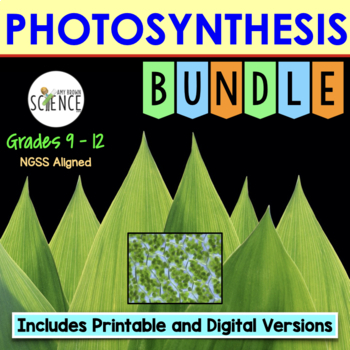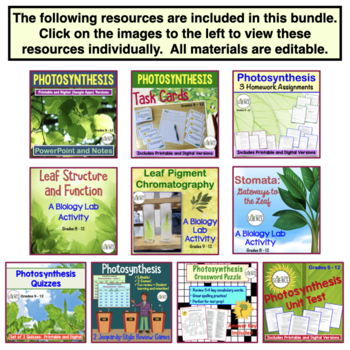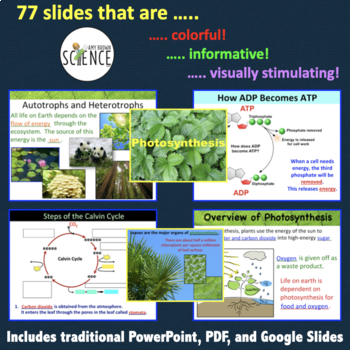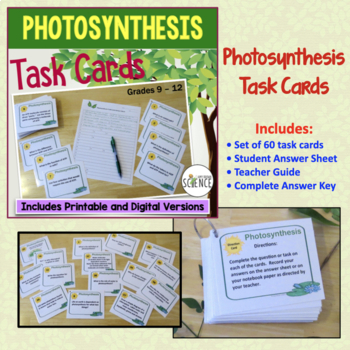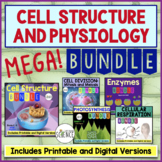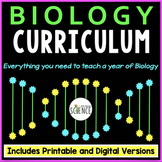Photosynthesis Unit Bundle - PowerPoint Notes Labs Activities Worksheets Quizzes
- Zip
- Google Apps™

What educators are saying
Products in this Bundle (10)
showing 1-5 of 10 products
Bonus
Also included in
- Five of my best-selling complete teaching bundles are included in this one Super-Mega-Bundle! This bundle includes all of the PowerPoints, notes, labs, task cards, homework assignments, review games, quizzes, activities, and unit tests that you need to teach complete and comprehensive units on cellPrice $189.99Original Price $268.09Save $78.10
- This NO PREP, PRINTABLE, EDITABLE, AND DIGITAL Biology Curriculum contains everything you need for an entire year of Biology! For less than $3 a day, you can save your time, energy, and sanity. Each of the 20 Complete Units includes a teaching PowerPoint presentation, notes, labs, homework assignmenPrice $525.00Original Price $988.18Save $463.18
Description
It's all here! Everything you need to teach a complete unit on photosynthesis to your biology students. This photosynthesis bundle covers topics related to chloroplasts, pigments, leaf anatomy, the light dependent reaction, the light independent reaction, and energy transfers. See detailed list of topics below. Resources are available in BOTH printable and digital formats. Resources include a 77-Slide Powerpoint presentation packed with colorful and interesting photographs, teacher notes, student notes, task cards, 3 labs, 3 homework assignment / study guides, 2 jeopardy review games, 3 quizzes, crossword puzzle, and a final unit exam.
From the engaging PowerPoint to the final unit test, this bundle contains loads of editable and NO PREP materials that are ready to be used with your students. Many of the resources in this bundle are available in paperless digital formats for use in Google Drive, Google Classroom, Microsoft OneDrive, or similar.
What is included in this bundle? ( Items marked with ** have both printable and digital versions.)
- Photosynthesis Powerpoint with Teacher and Student Notes
- Photosynthesis Task Cards
- Lab: Leaf Structure and Function
- Lab: Pigment Chromatography
- Lab: Stomata - Gateways into the Leaf
- Photosynthesis Homework Assignments - Set of 3
- Photosynthesis Crossword Puzzle
- Photosynthesis Quizzes - Set of 3
- Photosynthesis Powerpoint Jeopardy Review Game
- Photosynthesis Unit Test
Teacher Guide containing tips for implementing the resources, suggestions for sequencing, and alignment to NGSS standards is also included.
Teacher Answer Key is included for each resource.
Topics covered are:
- Autotrophs, Heterotrophs, the flow of energy through an ecosystem.
- Chemical energy and ATP: Definitions/explanations of ADP and ATP, the structure of ATP, how ADP becomes ATP, uses of ATP.
- Overview of photosynthesis: Reactants, products, and an equation for photosynthesis.
- Chlorophyll and other pigments: pigment, chloroplasts, electromagnetic spectrum, visible spectrum, absorption and reflection of different wavelengths of light, types of chlorophyll.
- Leaf Anatomy: Students will label the parts of a leaf and define cuticle, palisade, spongy cells, mesophyll, stomata, vascular bundle, xylem, phloem
- Structure of the Chloroplast: Students will label a drawing and define outer membrane, inner membrane, thylakoids, grana, stroma, chlorophyll, photosystems.
- Electron carriers: Short discussion on electrons, energy levels of electrons, excited electrons, electron transport chain, NADP+, NADPH.
- An overview of the stages of photosynthesis: Light dependent reactions and light independent reactions. Includes an equation for photosynthesis that outlines the reactants and the products of photosynthesis.
- The Light dependent reactions: Photosystem I and photosystem II, splitting of water molecules, electron transport chain, production of ATP and NADPH, release of oxygen, ATP synthase.
- Calvin Cycle: Includes basics of carbon fixation, reduction of PGA to form PGAL, regeneration of RuBP, how glucose is formed.
- Alternative Pathways: Water loss from the plant, the C4 Pathway, the CAM pathway.
- Factors affecting the rate of photosynthesis: water, temperature, light intensity.
For updates about sales and new products, please follow my store:
My TpT Store: Amy Brown Science
You can find me at these locations as well:
My Blog: Amy Brown Science.com
Instagram: @AmyBrownScience

